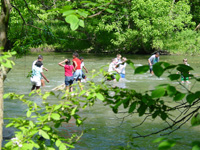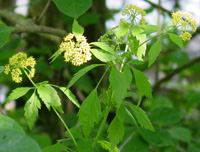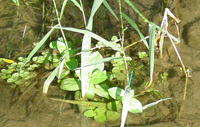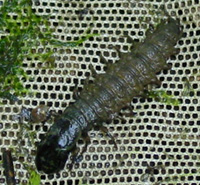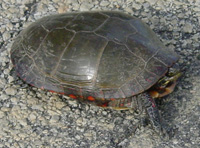

National Standards Life Science Levels 5-8 Levels 9-12 – Understand measurable attributes of objects and the units, systems, and processes
of measurement Mathematics Number and Operations – Understand numbers, ways of representing numbers, relationships among numbers,
and number systems
|
Don your boots. Grab a bucket, kick net, and water testing kit. Then, head for the nearest creek for a great adventure. Discover all sorts of creatures and plants that live in this aquatic habitat. Investigate the health of the creek and its impact on the overall environment. Observe and chart change over time by returning to the site more than once. Be sure to follow safety procedures and to return everything to its original location. Prepare for your journey by visiting these Websites for information and lesson ideas. Delta Labs, a non-profit organization, sponsors the Adopt-a-Stream program for all ages. A 12-step guide leads you through the process from registration to the actual stream analysis. An excellent article on Testing Water Quality is a must read for teachers. The Water Detectives (grades 4-8), The Ecological Exploration (grades 6-9), and The Ecological Integrity (grades 9-12) teaching guides and student workbooks are available on CD-ROM for a nominal cost. Aquatic Education – Iowa Department of Natural Resources The Iowa DNR has a variety of materials for educators and youth leaders. For younger children, download the Aquatic Animals Activity Book that contains dot-to-dot, coloring, and drawing pages with a sentence describing each animal. If you need quick information with color illustrations, click on Aquatic Habitat and Species Fact Sheets. These are organized by category on one page for easy access. Be sure to read Goin’ with the Flow, a hands-on lesson about the Riparian Zone of waterways. It includes complete details on how to plan and implement the project, including a timeline, activities, and resources. Keeping the Big Darby Creek healthy has led to many conservation programs in Columbus, Ohio and its surrounding communities. At the Website, there is a fine example of the history of the creek from a cultural, geological, and biological perspective. Ecosystems are another interesting aspect of the watershed and provide insight into past and present conditions. For instance, there are remnants of the tallgrass prairie that once covered a vast section of Ohio. For those who want to make an inexpensive dip net for capturing specimens, you will find an illustration showing how to improvise with household items. Techniques for using the dip net are also explained. Need guides for collecting, storing, and identifying aquatic insects? The Michigan Odonata Survey functions as a gateway to loads of resources. Creek Connections is a partnership between Allegheny College and regional K-12 schools and uses the local waterways as outdoor laboratories. Data collected from the studies is available to the public. Classroom resources are an outstanding feature at this site. Water chemistry, aquatic insect fact sheets, testing tips, and studying waterways are some of the materials available for downloading and printing. In addition, there are original word searches, Creek Geek Knowledgy, and matching games. This is a great site for elementary teachers and students. . Frogwatch USA is a frog and toad monitoring program managed by the National Wildlife Federation in partnership with the United States Geological Survey. It gives you an opportunity to help scientists conserve amphibians. With as little as 20 minutes a week you can collect essential information to protect frogs and toads. Step-by-step instructions are provided to assist you with the process of registering, monitoring, and reporting. Gear up for a day at the creek testing Ph, water temperature, dissolved oxygen, and collecting aquatic insects. Instructions and materials needed are listed as well data sheets and graphs for testing water quality. A Bug ID chart for identifying macroinvertebrates will help students in their roles of director, recorder, technician, and materials specialist. Directions for creating a fishless aquarium promote the understanding of ecosystems. The site includes information and diagrams of the metamorphosis of aquatic insects showing their life cycles. Kids in the Creek is an excellent resource for assisting students in learning how to assess the long-term health of streams. This is a must read for teachers planning a field trip in which students will study macroinvertebrates and water quality. It provides a brief overview of macroinvertebrate anatomy, behavior, and ecology with well placed illustrations. The entire document is an excellent starting point, especially the section on sampling methods. Learn how one school district in California studied the Mission Creek Watershed’s history, geology, and restoration. Photographs, charts, and a guided tour provide information on creating an outdoor experience to illustrate environmental concepts. Activities and lesson plans are included for all age levels to promote an appreciation and understanding of how streams work and why they are so important ecologically. This project received the Distinguished Project of the Year award for 2004 by the American Public Works Association of Northern California. Stream Invertebrates Resources Meet the invertebrates
through art and photography. Follow the process of determining
the water quality of streams
by identifying water
life. Play the game Stoneflies and Aquatic Worms, and use the Identification
Key for stream insects. Print the macroinvertebrate count sheet to
assist in keeping a tally of creek life. Don’t miss the stream
invertebrate movie on habitats and water quality. The teacher guide
provides step-by-step instructions for using the movie with students.
Handouts for student work can be printed from the student guide.
The photographs of the Stream Team Does Critters will assist when
planning for a day at the stream. And don’t forget to take
your camera. |
Lessons Stream Study (Cyberbee Learning) Learn how aquatic organisms can be indicators of water quality by taking a macroinvertebrate count. Observe creek vegetation. Sketch plants and trees. Keep a photo journal. Calculate stream flow by measuring a cross-section of the creek. Download the entire packet or individual sections. Stream Study Lesson (Complete Packet) Using this guide students learn about the relationship between macroinvertebrates and water quality. The lesson is geared to grades 6-12 and aligned with the California State Standards. Watch this video for instructions on how to measure stream flow. Calculate the flow of a stream through this hands-on lesson from the National Park Service. The data sheet is easy to follow. Older students can practice calculating stream flow using Go with the Flow, an interactive tool. To Protect Your Streams, Protect Your Mountains In this lesson for grades 5-7, students build a watershed and learn about the natural movement of water. They also discover how human activity can be either detrimental or beneficial to the stream environment. Clip Art The Florida's Educational Technology Clearinghouse offers over 7500 illustrations of a broad range of animals from the kingdom Animalia, including amphibians, birds, crustaceans, fish, insects, mammals, and reptiles. A friendly license allows teachers and students to use up to 50 items in a single, non-commercial project without further permission. Wisconsin Water Resources Clip Art Collection If you need clip art for a water quality project, this is the place to find it!
|
||
|
||||
Updated March 14, 2015
© 1996 - 2015 Linda C. Joseph
All Rights Reserved
All CyberBee Graphics are Trademarked
Graphics by
Darlene Vanasco/Creative Director
Erika Taguchi/Designer & Illustrator
Hosting Provided by Iwaynet
